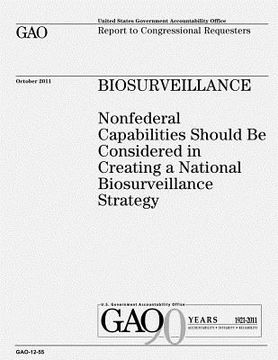Biosurveillance: Nonfederal Capabilities Should be Considered in Creating a National Biosurveillance Strategy (in English)
Synopsis "Biosurveillance: Nonfederal Capabilities Should be Considered in Creating a National Biosurveillance Strategy (in English)"
The nation is at risk for a catastrophic biological event. The Implementing Recommendations of the 9/11 Commission Act directed GAO to report on biosurveillance--to help detect and respond to such events--at multiple jurisdictional levels. In June 2010, GAO recommended that the National Security Staff lead the development of a national biosurveillance strategy, which is now under development. This report focuses on nonfederal jurisdictions, which own many of the resources that support a national capability. It discusses (1) federal support for state and local biosurveillance; (2) state and local challenges; (3) federal support and challenges for tribal and insular areas and (4) federal assessments of nonfederal capabilities. To conduct this work, GAO interviewed select federal-agency, jurisdiction, and association officials and reviewed relevant documents. To collect information on federal efforts and challenges, we also sent standardized questionnaires to seven states and two cities. The federal government has efforts to support health preparedness that state and city officials identified as critical to their biosurveillance capabilities. The efforts these officials identified fell into four categories: (1) grants and cooperative agreements, (2) nonfinancial technical and material assistance, (3) guidance, and (4) information sharing. Within each of the categories, the officials identified specific federal efforts that were essential to their biosurveillance activities. Because the resources that constitute a national biosurveillance capability are largely owned by nonfederal entities, a national strategy that considers how to leverage nonfederal efforts could improve efforts to build and maintain a national biosurveillance capability. State and city officials identified common challenges to developing and maintaining their biosurveillance capabilities: (1) state policies that restrict hiring, travel, and training in response to budget constraints; (2) ensuring adequate workforce, training, and systems; and (3) the lack of strategic planning and leadership to support long-term investment in cross-cutting core capabilities, integrated biosurveillance, and effective partnerships. A national biosurveillance strategy that considers planning and leadership challenges at all levels of the biosurveillance enterprise may help partners across the enterprise find shared solutions for an effective national biosurveillance capability. The federal government provides some resources to help control disease in humans and animals in tribal and insular areas, but there are no specific efforts to ensure these areas can contribute to a national biosurveillance capability. Resources include cooperative agreements, disease-specific funding, training, and technical assistance. Surveillance capacity varies among tribes and insular areas, but common challenges include limited health infrastructure including human- and animal-health professionals and systems. The federal government has not conducted a comprehensive assessment of state and local jurisdictions' ability to contribute to a national biosurveillance capability, as called for in presidential directive. According to federal, state, and local officials, the magnitude and complexity of such an assessment is a challenge. Until it conducts such an assessment, the federal government will lack key information to support a national biosurveillance capability. A national strategy like the one we previously recommended--one capable of guiding federal agencies and its key stakeholders to systematically identify gaps, resources to address those gaps, and investment priorities--would benefit from an assessment of jurisdictions' baseline capabilities and critical gaps across the entire biosurveillance enterprise.

